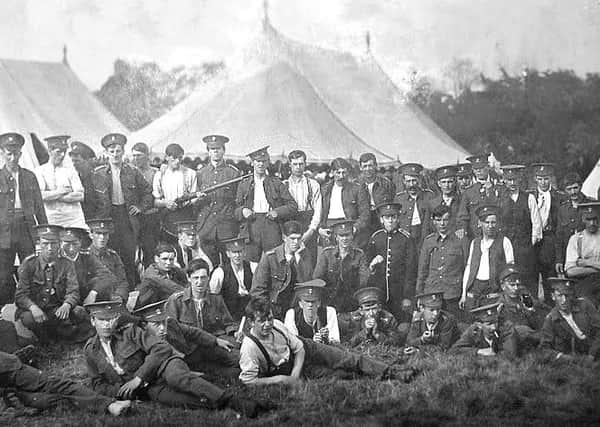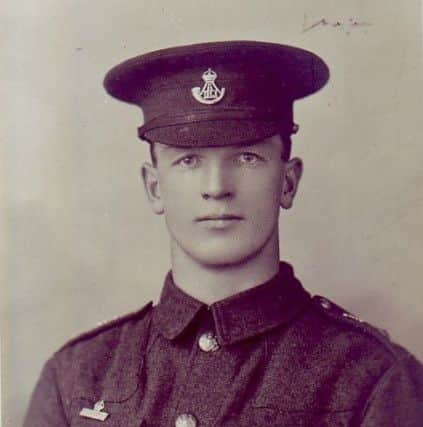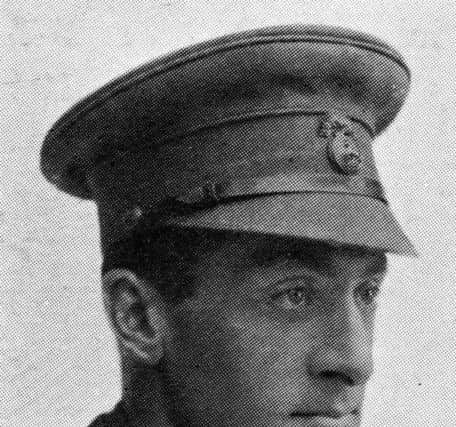ARMISTICE 100: Families pay a heavy price in the horror of war


Last week, we learnt of Corporal William Purvis, who was twice awarded the Military Medal, and of George Balmer, another MM recipient, one of four sons lost during the war.
Another family to lose four sons was that of Robert and Thomasina Blythe Egdell, of Kirk’s Buildings, New Row, Alnwick.


Advertisement
Hide AdAdvertisement
Hide AdEdward (Teddy) Egdell was the first of their boys lost when he was killed on July 20, 1916, during the early stages of the Battles of the Somme.
At 35, before the war, he served in India with his regiment, the Cameronians (Scottish Rifles) 1st Battalion.
He had been discharged but re-enlisted on the outbreak of war. He is commemorated on the Thiepval Memorial.
An older brother, 39-year-old Acting Petty Officer Thomas Egdell, DCM, a miner before the war, was next to be lost, on September 24, 1917. He enlisted as a Private in the NF on September 2, 1914, but was one of the 1,500 or more men from the North East transferred to the Royal Naval Division later that month, in Thomas’s case to Hood Battalion.


Advertisement
Hide AdAdvertisement
Hide AdThomas’s unit served at Antwerp, then with the Mediterranean Expeditionary Force (MEF) from March 1, 1915, to May 7, 1915.
He was wounded and invalided to the UK on June 7, 1915, but returned to the MEF in a draft on December 5, 1915, re-joining his battalion at Mudros on January 8, 1916.
He succumbed to pyrexia (fever) of unknown origin from February 15, 1916, which disabled him until early 1917 when, again, he re-joined Hood Battalion.
Egdell served at Passchendaele. Originally reported killed in action on September 22, 1917, while out on patrol, his body was not recovered and it was later reported he died of wounds as a prisoner of war, on September 24, 1917.
Advertisement
Hide AdAdvertisement
Hide AdHe was awarded the DCM for action under heavy fire at Grancourt between February 3 and 5, 1917.
Barely a month after Thomas’s loss, the Egdell family would have again been devastated to learn that his younger brother, Corporal John Egdell, had been killed on October 26, when serving with the NF 1/7th Battalion TF. He is another of those men commemorated on the Thiepval Memorial.
Like his older brother Teddy, Private David James Blythe Egdell served with the Cameronians (Scottish Rifles) 1st Battalion. Born on September 5, 1891, David was killed on April 13, 1918. His body was never found, and he is commemorated on the Ploegsteert Memorial.
One family with grand military traditions was that of the late Frederick John Leather, JP of Middleton Hall, Belford, and his wife Gertrude Elizabeth Sophia.
Advertisement
Hide AdAdvertisement
Hide AdThey had six sons, all of whom served during the South African or Second Boer War of 1899-1902 and the First World War.
Three were killed within 18 months of the outbreak of war (for Britain, on August 4, 1914), while the second and fourth, Captain PC du Sautoy Leather and Lieut-Colonel Kenneth J Walters Leather, were wounded severely.
The eldest, Major GFT Leather, served with the NF.
The youngest son, Lieutenant Christopher Leather, 32, was the first to be killed, between October 25 and 27, 1914.
In November 1899, Leather was commissioned as Lieutenant in the 3rd (Militia) Battalion, Durham Light Infantry (DLI). He served with distinction in the Mounted Infantry in South Africa from January 1900 to May 1902. In 1901, he received a regular commission in the NF 1st Battalion, with which he remained until the conclusion of the campaign, receiving the Queen’s medal with three clasps, and the King’s medal with two clasps.
Advertisement
Hide AdAdvertisement
Hide AdHe retired from the Army in 1904, but re-joined his old regiment on August 20, 1914. He went to France as a Lieutenant in the NF 3rd (Reserve) Battalion and was later attached to the 1st Battalion. He was killed in action near Neuve Chapelle. He is commemorated on Le Touret Memorial.
The fifth son, Captain Edward Wilberforce Leather (35, Alexandra, Princess of Wales’s Own (Yorkshire Regiment), 3rd (Reserve) Battalion), was next to be lost.
He joined Yorkshire Regiment’s 3rd Battalion (5th West Yorkshire Militia) in 1899.
Promoted to Lieutenant in 1900, he served in the South African War and received the Queen’s medal and the King’s medal, both with two clasps.
Advertisement
Hide AdAdvertisement
Hide AdHe, too, retired from the Army in 1904 and re-joined his regiment on the outbreak of war, serving with the Expeditionary Force from November 1914.
Leather was promoted to Captain in February 1915 and, for a time, attached to 2nd King’s Own Yorkshire Light Infantry. He was killed in action at Hill 60, near Ypres, on April 18, 1915. His name is inscribed on the Menin Gate Memorial at Ieper (Ypres).
Major Ernest Arthur Leather joined the NF 5th Militia Battalion as a 2nd Lieutenant on May 23, 1900. He served at Malta during the South African War and retired from the Army in 1910 with the rank of Captain.
Leather re-joined his old regiment in August, 1914, and was appointed second-in-command of the NF 10th (Service) Battalion. Promoted to the rank of Major in October, 1914, he was unable to go overseas with his battalion following a bad accident, caused by the falling of a horse.
Advertisement
Hide AdAdvertisement
Hide AdOn his recovery, Leather was posted to the regiment’s 15th (Reserve) Battalion, before being attached to 27th (Service) Battalion (4th Tyneside Irish) for service overseas. He disembarked in France on January 11, 1916, but was killed in action near Fleurbaix only a month later, on February 10. He is buried at Rue-David Military Cemetery, Fleurbaix.
Company Sergeant Major Thomas Chrisp, MM, (DLI, 1/8th Battalion TF) was the son of Isabel Ann (Annie) Chrisp and the late Thomas Chrisp, who had been a policeman.
Born on October 7, 1892, at Otterburn, Chrisp had two sisters and a brother. The family moved to Wooler in 1905, shortly after which Thomas Snr was promoted to Inspector Thomas Jnr, then, was 12 and attended Wooler Church of England School.
From September 1906 Chrisp attended the Duke’s School, Alnwick, and worked part-time as a pupil teacher at his old Wooler school, then Alnwick Church of England School from early 1911.
Advertisement
Hide AdAdvertisement
Hide AdIn 1911, he began working as an assistant at Guide Post Primary School, Choppington. His future wife, May Dickinson Hedley, started working there on the same day.
Chrisp attended Bede College, Durham, from 1912-1914 to train as a teacher.
He married May on June 24, 1916, at Hexham Abbey, a month before he re-joined his regiment abroad.
Their son, John Thomas Hedley Chrisp, was born on March 17, 1917. May returned to teaching in 1920.
Advertisement
Hide AdAdvertisement
Hide AdWhen war broke out, Chrisp was attending the annual training camp of the Bede College TF unit at Conway, North Wales.
He volunteered immediately and was given the rank of Sergeant. After training, his battalion left for France on April 19, 1915.
Chrisp took part in 2nd Battle of Ypres (April 25, 1915) where he was shot through his right arm and left thigh. He returned to England and, after his recovery, was involved in training new recruits when he was promoted to Sergeant Major.
Chrisp re-joined his battalion in July 1916, near Ypres, and then travelled towards the Somme. For the resourceful leading of his platoon during the capture of the Fleurs line at the beginning of October, he was awarded the MM.
Advertisement
Hide AdAdvertisement
Hide AdIn June 1917, his unit was holding trenches near Cherisy. At 8am on Saturday, June 23, he was hit by a fishtail bomb (wizz-bang) and killed outright.
The most recent photograph received for the database came from the archivist of Downing College, Cambridge. This arrived on October 8, 100 years to the day since Captain William Wallis Everett, another teacher before the war, was killed in action at Grancourt, France, just weeks before its end.
Born on September 20, 1891, he graduated from Cambridge in 1913, and secured a teaching position at Duke’s School in Alnwick.
While at Cambridge, Everett had been a member of the Cambridge University Officer Training Corps and so, following the outbreak of war, he gained a commission as 2nd Lieutenant soon afterwards with the Norfolk Regiment 9th (Service) Battalion).
Advertisement
Hide AdAdvertisement
Hide AdHe first arrived in France on August 30, 1915, and after a considerable period, during which he attained the rank of Captain and was appointed Battalion Adjutant, he was sent back to England as an instructor at a Cadets’ Training School.
He returned to France again early in 1918. Everett was attached to his regiment’s 2nd Battalion when he was killed in action. He now lies buried at Montbrehain British Cemetery.